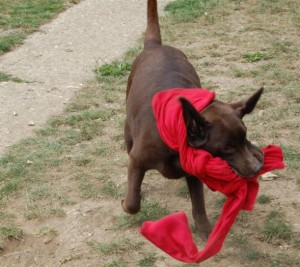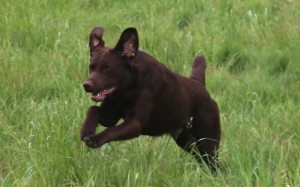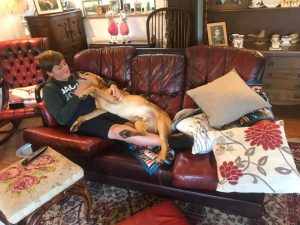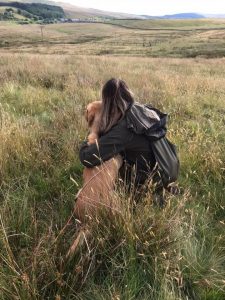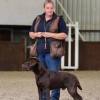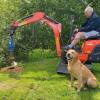What is a Labrador?
What should I expect from one?
Q: What physical traits do Labrador’s have?
The breed is split between two fairly differing lines of dogs. ‘Show lines’ and ‘Working lines’. The typical physical differences between these two quite different creatures are that Show Line dogs tend to be broader in frame, heavier coated, thicker tail, bigger head. They appear more ‘compact’ because their frame is ‘chunkier’. Their broader and wider features often unfairly get them the label of being ‘fat’…. When infact they are simply filling out the frame they were born with, broader hips, shoulders, deeper chest, thicker leg bones etc.
Working line physical characteristics, tend to lean towards being taller than show lines. But ‘appear’ smaller’ as they are narrower, finer in build, slighter in bone, narrow across the chest, thinner in thigh and less defined in shoulder. Skulls tend to be longer and less broad between the ears. Physically Working lines do tend to be more athletic, because, they are built like an athlete.
The weight difference between a male and female, and *then* also factor in, between show and working lines (and any mix of show/working in-between in a mating) gives us absolutely NO average ‘weight’ scale for a Labrador. Some working bred dogs appear lighter, but on the scales are just as heavy as their show-bred cousins. Anything from 20kgs to 45 kgs is a perfectly respectable weight for a Labrador adult…. depending on all the so many factors discussed.
Do not buy a Labrador puppy if you have a specific idea in your head of how your adult *should look*. Its the BREED you are buying. It may end up with the physical traits of Mum, Dad …. or Uncle Harry three generations ago! Its certainly right to look at whether you prefer *generally* the show look, or, the working look, or maybe a mix of both…. But any further than that – You’ll be disappointed to be too specific. The breed is too diverse.
Q: Character of a Labrador ?
Again, only stereotypes can be drawn, as truthfully? The breeder can give the pup 8 weeks of their time and love and boundaries and routine…. But if you, as an owner, come along, and let it run riot, do as it pleases, create no boundaries and few rules, fuss over it too much, raise its expectation on what is ‘its daily RIGHT!’ etc etc etc, you can create a Monster, from what was, a genetically lovely dog in an equally short number of weeks.
Generally speaking, books will tell you the truth. That a Labrador is a diverse, people orientated, social breed with a love of life and a will to please. This is true. Mostly.
The problems tend to play out in that modern Labrador lines – whether show or working – *tend* to have been bred so heavily towards BEING social, and bold and outgoing…. that this genetic confidence, literally from 8 weeks old, can overspill into a madly over adrenaline’ized creature, who is hard to control in social situations, demands attention from all it meets (immediately upon meeting them, hence a lot of jumping up!) and whilst is perfectly biddable and loving, literally loves… EVERYONE!
This sounds very endearing, till the dog is an out of control 8 month old of 35KGS with little lead control and non existent recall off lead, hurling himself at every visitor who sets foot in your house! So the downsides of that lovely happy nature. That sunny ‘Life is wonderful’ attitude. His ‘a million miles from biting the Postman!’ disposition, is they are hard damn work to make into a self controlled, pleasant to take out in company, companion.
At home, given good boundaries and not allowed run of the house too young etc etc, they are usually friendly, loving and hugely cuddly. They do have an ‘offswitch’ unlike some working breeds (but only if that is enforced from a young age with lots of crate time even when people are home, and the dog is not left to free-roam as it sees fit all day long, making it a Duracell Bunny).
Q: What Other Things can I expect from my Labrador?
There are so many good sides to owning such a friendly breed. Please don’t immediately let me put you off, but lets look at some of the other things, there’s no way you can gloss around.
They can be destructive. They are a mouth orientated breed. They were made to carry things about. Therefore, they like to carry things about! Which, again, is hugely endearing….. except often they then won’t wish to share that thing ‘with you’.
So much specific work from a young age, to not falling into the trap of teaching the young dog to play ‘can’t catch me’ with items he decides he values when he has them’ is important (and that doesn’t involve spending the first 3 months bellowing ‘drop! drop! drop!’ every time the pup has something in its mouth! Tha’ts what MAKES the ‘sharing things with you *problem*’)
Also that ‘mouth orientated tendancy’ can lead to a fair bit of destruction of, very normal, items left laying around, to an unsupervised or uncrated dog. So plenty of putting things out of reach, bins on work surfaces, shoes in cupboards, kids toys away, etc is a skill you will discover VERY quickly. Plus leaving the dog with access to soft furnishings, electric points, charging cables, and ornaments etc can be a hiding to nothing. They are chewers and often shop bought things to ‘distract them with’ are not as fun as your skirting board, dining room table leg, or corner of the doorframe. 🙁 Management is king. Not allowing this to start is king. Supervision and when you can’t supervise, crated is ABSOLUTELY king!
They are greedy. They love food. This is GOOD as they are rarely fussy eaters. You can get tablets down them when needed easily. They tend to have guts of iron. BUT they can be thieves. They can snatch when offered food. They can eat very VERY quickly (this is normal, don’t stress), except they may then throw their food up…… and eat it again! They are dustbins. They eat snails, stones, bits of paper, bird poo, dog poo, sheep poo, cow poo……. POO!!!!! They don’t have our refined tastes, i’m afraid. If its on the ground, its fair game. Its a Macdonald’s Drive Thro! Being honest it rarely causes them the slightest problem… but it can disgust the more delicate owner. So be prepared! You bought a greedy, mouth orientated, unrefined carnivore….. not a teddy bear or a Poodle 😉
Q: Health Problems?
No breeder is a soothsayer, but they CAN give you a huge leg up, on a long and healthy life for your dog, by scoring hips and elbows on both parents. By annually eye testing for congenital problems on both parents. And by DNA testing one or both parents for several more common recurring breed problems. And making no pathetic excuses on these small things before breeding.
From there, the Labrador is a generally healthy breed. It can occasionally be prone to allergies. Skin problems, taking a long time to recover from soft tissue injuries (because of its love of life and running!), some cancers, crutiate ligament ruptures, some epilepsies, ear infection problems and almost anything else you can imagine. HOWEVER, that said, the gene pool is VAST and therefore you WILL sadly, get a ‘bit of everything’ now and then even in generally very fit and healthy ‘lines’ of dogs. No ‘line’ is perfect, whatever the breeder blindly tells you! 🙂 Most Labrador owners, have long happy lives, with a robust and healthy Labrador. Some don’t. You tend to hear MORE from the ones that don’t, than the ones that DO, these days with social media, so don’t be too fooled.
Q: Do they need tons of exercise?
No. And infact, the more you give, the fitter they become, and the more they will expect. Which is GREAT on a Saturday and a sunny Sunday, but on a busy rainy Tuesday in January, a dog expecting a two hour hike, and not settling without, is a USELESS family dog that the owner has soundly broken by raising its expectation FAR too high.
Whilst some find it hard to grasp, a dog doesn’t need a walk every day! It needs love, and a bit of time, and a small to medium garden to do its business in. Walks frankly bring very little but grief to your ownership ‘party’, (recall problems, shit eating, lead or car excitement) so make your routine not driven around them. Your Labrador gets fat when you FEED it too much, NOT when you don’t walk it enough. Half an hour a day is PLENTY. Some days don’t walk at all to teach it an important life skill that its not an everyday thing (for if you are away, ill or just unable to some days in life!).
If you are a huge walker, fine, a Labrador will match you stride for stride. But I’d go for a lighter framed, Working bred Labrador. Show line dogs tend to be more grateful with short walks and a good bit of sofa dwelling 😉
Q: Are Labradors good with Children?
Yes. Kind of. If you manage it correctly. They can however act in a rough, sometimes painful, canine play ‘sort of a way’. They tend to be a ‘all in’ kind of a breed. So they leap at you, or they stamp on you, or grab for something…. and it CAN be frightening to children if repeated many times. Even in little pups. Again, its that confident, social gene. Some breeds you might take weeks trying to get it to accept the children. The cat. The Dustmen. Not a Labrador! They are BORN knowing ‘everything was put on this world for their entertainment!’ so its all about teaching them that these good things are NOT here for their amusement, and there will be boundaries surrounding them. Enforced ones. Not ASKED for ones. They do get shut in the crate to calm down if they get too hectic around the children (or the children do, even better solution!! 😉 ) Not for punishment, just to create space and time and calmness in a spiralling situation!
Yes they are very forgiving of children’s clumsiness, inadvertant shrieks and painful grabs, but not always. They are a dog remember. Whatever breed they are. Its usually more about if the CHILDREN forgive the dog for its jumping, lunging, rough play, destruction of anything they accidentally leave laying about….. etc. And YOU, the adult, being both realistic and fair about this. They are NOT Disney playmates. They are actually often polar opposites who need careful shielding from one another for huge parts of the day for everyone’s sanity.
Q: In conclusion?
No dog could love more openly, warmly, completely. But there are negatives to all that love, and I hope i’ve given you a realistic view above. Of COURSE there are exceptions. But this is a genuine overview of ‘the norm’. Owner boundaries (there’s that word again!!!) expectations, and commitment to making their wants and ‘not wants’ as clear as possible, as young as possible, and sticking with it…. Is the way forward.
To ME, with 30 years experience, they are NOT a dog for a home with very small children if a first time owner. You have enough to do without bringing a massive complication and another needy creature in.
They are NOT for an elderly person’s home, if raised from a puppy with them, as they can be SO strong by young adulthood. However rehomings, with older people of older aged, quieter dogs of this breed, can be WONDERFUL arrangements.
They are not a breed for someone who likes a remote control ‘do it because I told you to once’ type dog. They are free spirited (which you can and must, rein in to as great an extent as possible) and spacially useless.
They are clumsy, so picture perfect homes need not apply for such a breed.
I ADORE Labradors. But I work everyday to MAKE them fit *my image* of ‘adoreable’, be prepared to make that commitment too. Its all in the detail, not hours of training, and they will change your life and everything in it! 🙂
Diana Stevens – 2022


